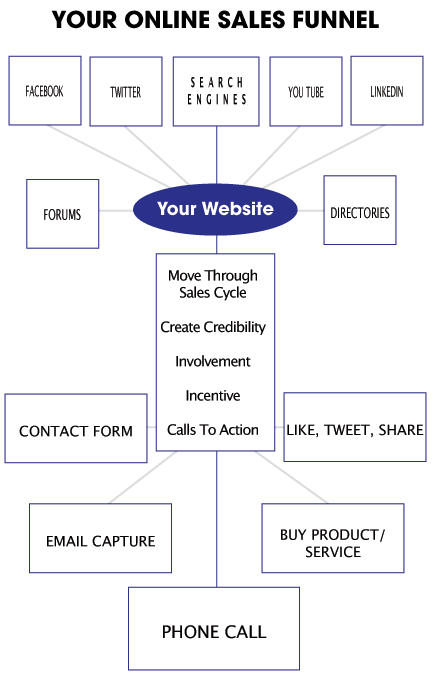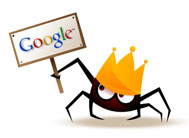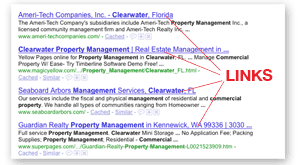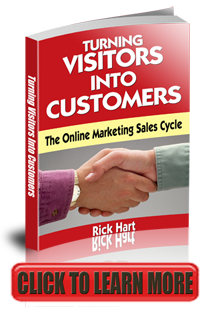Once you understand your business’s Sales Cycle it’s time to create the tactics that move people through that Cycle. Those tactics are called your Sales Funnel.

Online Marketing Sales Funnel
And these tactics actually begin off your website where you meet potential customers.
Where Are They Now?
People that have the problem that you can solve could be anywhere online.
- They might be searching for solutions on Google, Yahoo, or Bing.
- They might be hanging out on social media sites like Facebook, Twitter or LinkedIn.
- They might be reading an email from you.
- Through your advertising on Google, Facebook, or any relevant online location
- They might be offline in networking situations, or any place you might meet someone offline.
But realize, as you meet people on Google, Facebook, LinkedIn, Twitter, your blog, your website, or even offline in person, they could be at any stage of the sales cycle.
Some may not even realize they have a problem, while others may be ready to buy, credit card in hand.
You must be able to respond with the answers to the questions they have right at that moment, wherever they are in the sales cycle. In other words, you must meet them “where they are now” in the sales cycle.
The beauty of online marketing is you can create an automated process where someone can move themselves through the sales cycle without you needing to be involved. They’ll just buy. You may not know how or why. They have gotten all their questions answered and just bought.
Of course, it’s not always this easy, but it can be when done correctly.
Getting Their Attention
The first step in any sales or marketing process is getting your prospect’s attention. Without getting their attention you really can’t begin to move someone to your Most Wanted Response (MWR). Actually there’s not just one MWR there’s a series of MWRs that we’ll talk about later.
So where and how do you get people’s attention?
You Must Understand The WIIFT
All people respond to What’s In It For Them. They have a need or a want they would like to satisfy. If you can understand their underlying need, you can talk in terms of that need to get their attention.
For example…
“Are your drives getting shorter and shorter as you get older? The new Taylor Made R11 driver will add 10-20 yards to your drives immediately.”
“Is stress causing you to be impatient with your kids? Learn these simple techniqes for reducing stress in your life.”
“Do persistent headaches keep you from enjoying life? Learn this natural cure that will make headache pain a thing of the past.”
Notice how each of these paragraphs mentions the pain and then the benefit of the solution. There’s a reason they are structured this way.
People Buy Benefits
So using benefit driven language in all your writing gets people’s attention because it’s what people are looking for. It’s What’s In It For Them.
Where To Meet Prospects
Again, going on the concept of “meeting them where they are now,” you must meet prospects in the online locations where people gather. The possible places include…




- The Search Engines
- Social Media Sites
- Business Directories
- YouTube, and other popular sites
- Through Email Marketing
And your particular business, may have unique “touch points” of its own. There are many websites that cater to particular business niches like lawyers, tradesman, or health care. If that is your business category you’ll want to get listings on these directories.
So having a web presence on all the possible touch points gives you the opportunity to get people’s attention in as many places as possible. This means a website, a blog, Facebook, Twitter, YouTube, directories, and niche websites.

Online Marketing Sales Funnel
Some Places Are Better Than Others
One important thing to think about with these online touch points is “why are they there?” In other words what is their intention?
When people go to Google, or Facebook, or YouTube they have a particular intention. Sometimes they are there to solve a problem and sometimes they may be there to socialize or have fun, and perhaps avoid the problem. So the degree of “buying intention” that someone has on each online location is an important factor to consider in your online marketing.
That’s what made the Yellow Pages such an effective advertising medium.
When someone picked up that phone book, you knew they were trying to solve a problem and had plenty of buying intention. But with the demise of the Yellow Pages, the new problem solving location is the Search Engines. They’re faster and can go deeper into finding the right answer and the right solution.
Think about it…
When people go to Google they are often there to find a solution to some question or problem. They are searching for information that either helps them answer that sales cycle question or they may already be fully aware of what they want and are just trying to find the best product or service to meet their needs.
That’s why getting high rankings in the Search Engines should be the number one focus of your online marketing activities.
You still may want a presence on Facebook, Twitter, directories and other online locations. But the best “bang for your buck” will be search engines for the foreseeable future.
And another point…
On the search engines the quality of people’s attention is much better.
When someone is actively trying to solve a problem themselves they are much more engaged in the process. Compare that to when someone tries to get their attention when they were doing something else.
That’s why “interruption marketing” tactics like direct mail, TV ads, newspaper ads, or even online banner ads, don’t work as well. Search engines let people find answers themselves. People always like it better when they think finding the solution was their idea.
After all, as the old marketing adage says…
“People love to buy, but they hate to be sold.”
Search Engine Optimization
To get high rankings for your website on Google, or any search engine, you must convince the search engine of two things.

- You must show relevance to the search term being used
- You must show authority in your niche
The process of making these two things happen is called Search Engine Optimization, or SEO.
SEO tactics involve a combination of on-page (on your website) and off-page (on other websites) actions that convince Google you deserve to be ranked highly on the Search Engine Results Page (SERPs).
And getting on that first page of Google is critical. Research shows that over 90% of all searchers never make it to the second page of Google. So if you are on page 2 you might as well be on page 200.
This is not a conversation about SEO so we won’t go into the details. If you’d like to learn more you can go here.
But to be clear, you can’t get people’s attention if your online touch points are invisible. Getting ranked in the Search Engines is a critical first step in getting people’s attention online.
Social Media
Any conversation about online marketing would be remiss if it didn’t discuss the biggest change in online marketing in the last 15 years. Of course, this is more than just an online shift. It’s also a major cultural paradigm shift as well.
Unless you are under a rock you know that Facebook has become a major social phenomenon. As of December of 2022 there are over 2.93 billion active Facebook users. And 50% of those users login every day. They say the average user spends over 6 hours per month on the site. Of course, active users spend a lot more than that.
And Twitter, Instagram, TikTok, LinkedIn, and YouTube have also become major players as well.
What does this mean to your business?
That depends on your business. If you sell to consumers and your product falls into the entertainment, health care, cosmetic, or any “social” category, you may have lots of prospects to meet on Social Media.
If however, you are a professional like an accountant, lawyer, doctor, or financial advisor, Facebook may not be the best use of your marketing dollars and time. On the other hand, a Social Media site like LinkedIn, that caters to professionals, may be an excellent place to network with other professionals and other business leaders.
And networking is what you are doing on Social Media sites. You are not selling. You are meeting people, first as a helpful advisor, providing useful content, and then if you develop enough credibility you can gently move people into your sales funnel. Outright selling is frowned upon on Social Media sites. You’ll get ignored quickly if you are too pushy.
But it is clear, some sort of presence on Social Media can be effective. Just remember that for the most part you are not selling on these sites because most people are not buying. However it’s a good place to network and create credibility for you or your business by offering helpful and free information.
So your online strategy must include getting visible in online places where people gather. This must include Search Engines first, then other sites like YouTube, online directories and the appropriate Social Media sites.
Email Signature
One of the most often forgotten “touchpoints” is your email signature. If you send a lot of emails, or even if you don’t, your email signature is a great place to introduce people to your “solution”. It’s subtle, not spammy, and depending on the relationship you have with your email partner, completely appropriate.
I found a great source for creating powerful signatures that really grab someone’s attention. Go here to learn more.
Now That They’ve Found You – Now What?
OK you’ve finally gotten someone’s attention. You’ve connected with them on Google, or perhaps some niche-related directory. Hopefully they have some degree of buying intention and now you are ready to introduce them to your sales funnel.
In other words, you can begin to move them from “where they are now” to “where you would like them to be”… with the final goal of having them give you a call or fill out a contact form. We’ll get to the intermediate goals, or Most Wanted Responses momentarily.
You Need Links
Generally what you will use to move them to the next stage in the sales cycle is what is called a hyperlink. A hyperlink is what you click on to go to another website.
A hyperlink is a piece of programming code (in Hyper Text Markup Language) that links between one location on the internet to another. We won’t go into the technical details here, but understand this is the critical tool we use to move people through our sales funnel.
Sometimes the link will be from one website to another. And sometimes the link will be from one location on our website to another location on the same website (an internal link crucial to SEO).
The goal is to move them to the best place to have their implied question answered. This should increase their buying intention and move them closer to making a decision.
Ideally you want to send them to a very specific page on your website or blog. You want to send them to the page that answers the question they have at that moment.
These links will appear in…
- Google search result listings
- Facebook “status update” posts
- LinkedIn News Feeds
- Twitter “tweets”
- In directory listings
- On website pages and blog posts
- Your email signature
What Happens When They Get To Your Website
OK someone has clicked on your link and arrived at your website. Now what?
The answers is simple. Help them!
The most important skill for a marketer may be empathy. If you can put yourself in your visitors shoes and understand their needs then you have a better chance of keeping their attention and moving them through your sales cycle.
One aspect of online marketing that makes it special is people raise their hands and tell you what they need. They do that through the keyword phrases they use to search. Understanding keywords, and their implied intention, is where we get to use that empathy that helps make us a good online marketer.The fact is, some keywords are better than others.
Some phrase have more searches and therefore can lead to more traffic.
Some phrases have more buying intention and can lead to more sales.
So any good marketer should evaluate all the possible keywords for their business to find the ones that can bring them the most traffic and the most sales. They should also think through what stage in the sales cycle the phrase implies and what might be the next stage to move someone to.
At any rate, the search phrase someone uses indicates “where they are now.”
If they arrive on your site from a search using a phrase like “golf clubs” you know they have some sort of interest in golf clubs. But you don’t know much else.
If however, they reach your site using a phrase like “best deal on Taylor Made R11 driver” you know specifically what they need and how much buying intention they have. Clearly the second phrase is better than the first from a marketers point of view. It should convert to sales at a much higher rate.
But also, where they need to go next for a phrase like “golf clubs” is clearly different than for a phrase like “best deal on Taylor Made R11 driver.” This is where the art of understanding and managing your sales funnel comes in.
I say an art because it may sometimes be difficult to determine the needs of your visitors based on the keywords they use. A phrase like “golf clubs” doesn’t really tell you much. Perhaps they are interested in “golf club history”, or “golf club types”, or “golf club design”.
How do you really know how to help them?
The answer to that question is to give them options so they can help themselves. Again, these options come in the form of hyperlinks.
These links can be part of your pages navigation or perhaps contextual hyperlinks embedded in content of the page. If you give them choices they can choose for themselves what they need and move themselves to the next stage.
So this means you have to anticipate what your visitors might be needing next.
And don’t forget… your visitors may be at any stage in the sales cycle. So be prepared to offer them a buying link right away too. Some of your visitors might be ready.
Tracking – Your Most Important Marketing Tool
Again the beauty of online marketing is people raise their hands and tell you what they want. And then they move themselves through your sales funnel until they are ready to buy.
Unless you track their movements you won’t know what is working and what isn’t.
- You won’t know what keywords they used.
- You won’t know what links they clicked on.
- And you won’t know what pages they went to on your site.
All of this information is critical for understanding and managing your visitors. It’s also critical for making changes to your sales funnel so you can make it more effective.
The best tool to use for website tracking is a free tool called Google Analytics. With Google Analytics you can see how people got to your site, how long they stayed, and what pages they visited while they were there. You can learn more here.
You can see what types of computers they used and what countries they came from. You can even set up tracking tools to see what keyword started the process that eventually led them to your contact page or sales page.
Here’s how Google Analytics works.
- First you get a Google Analytics account.
- From your account you get tracking code for your website.
- You put that code on all your web pages.
- Google then automatically collects information from your website about all your visitors and what they do when they are on your site.
- Your Google Analytics account will show you reports on what happens on your website.
It’s really a marketer’s dream come true. There’s not many marketing or advertising tools that let you collect this kind of data… for free.
Your Most Wanted Responses
There’s certain things you would like your visitor’s to do once they get on your site. These are your Most Wanted Responses.
Of course you want them to give you a call or buy your product, but really there’s a series of other MWR’s that you would like to see happen.
These intermediate MWRs help you know if your are engaging your visitors and actually moving them through your sales funnel effectively. Combined with your tracking tools, watching these intermediate MWRs will tell you what’s working and what’s not.
There’s really a series of MWRs…
1. You’d Like Your Visitors To Stay
One of the first things you’ll notice in your Google Analytics data is how quickly people leave your site. This is called your Bounce Rate. This metric tells you the percentage of people who leave your site from the first page they land on.
It can be disconcerting to see that 60-70% of your visitors never make it past the first page they see. They never really even get into your sales funnel at all.
Some of the reasons people might not stick around…
- The site design is unprofessional
- The page they landed on really doesn’t answer their keyword question
- They can’t find “what’s in it for them” quickly enough
- Your site is overwhelming or too “salesy”
- They got there by accident or mistake (mis-clicked)
2. You’d Like Your Visitors To Read Your Content
Until someone starts reading (or watching) your content you can’t move them through your sales cycle. Your words are your tool for creating credibility for you and your solution. If they don’t read, you don’t sell.
Google Analytics data like Pages Per Visit, and Time On Site can give you a sense of whether people are reading your content or not.
Text Formatting Is Key
Website owners often make the mistake of formatting their content as if someone was reading a book. The web is different. People aren’t as committed to reading as when they buy a book or magazine. Plus it’s just harder to read online on a computer screen.
Often people want to decide if your content is worth reading before they commit. They skim headlines and subheads and bulleted lists first to see “what’s in it for them.”
The key to getting them to read is to format your pages in a very easy-to-read way using…
- short sentences
- short paragraphs
- lots of headlines and subheads
- bulleted lists
- bolding of key phrases and concepts
- graphics and pictures to hold readers attention
Don’t forget videos. More and more people like to see videos on a website. It’s a higher quality communication and very engaging for most visitors. It will keep your visitors on your site longer and get them to know you more quickly.
The classic communication axiom is…
“The more senses you can get your audience to use the more effective the communication.”
3. You Want Your Visitors To Trust You
Until your visitors like and trust you they won’t be taking many of your recommendations. This is sometimes called PREselling but I prefer to call it just creating credibility.
It’s much like when you first meet someone. Until you find common ground and shared interests, there really is no basis for a friendship or trust.
And without some degree of trust they won’t be sticking around long.
Here’s a couple of key strategies for getting your visitors to trust you…
- Put your picture on your site (even better a video)
- Tell your back-story in a personal way (no bragging)
- Share your passion for the subject that you have in common with your visitors. This is what I call the Common Emotional Context. It’s what you both care about.
- Share how your “solution” changed your life (again personal with no selling)
- Share testimonials from other people about you
- Share testimonials about your solution from other people
4. You Want Your Visitors To Engage
Now this sounds vague and hard to measure, but if you’ve taken care of 1-3 you should be able to ask for something that shows they are engaged in your sales funnel. I call this the “Involvement” stage of the sales cycle. This is where they “need” to know more and get committed to finding a solution (hopefully yours).
A good test is to ask them to sign up for your email list, newsletter or free gift. If they respond then you’ve moved them at least part way through your sales cycle.
Another good test for sales funnel is getting Facebook “likes” from your visitors. When they are willing to share your content with their Facebook friends, it’s not only a vote for you, but a chance to virally spread your sales funnel to their friends.
Note: If you are not familiar with how Facebook works… when someone clicks on a “like” button it means a post will be added to your visitor’s Facebook page (not yours). That post will have a link to your website, sometimes with a picture, or a few phrases from your web page. This is very cool and powerful for your site.
Of course, now we have buttons for Google+, LinkedIn, YouTube and lots of other Web 2.0 sites. These buttons should all be on your website. They create viral marketing links and help you by spreading your message.
5. Don’t Forget To Ask For The Order
Here’s a phrase that I remember from my sales training days…
“A good salesperson is always qualifying/closing their prospect.”
What this means to an online marketer is… you should always be asking questions, via a link, that leads to a higher stage in the sales cycle. Something like…
“Are you ready to learn how the Taylor Made R11 drive can add 20 yards to your drive? Click here.”
“Want to see how the Ultimate Stress Relief Toolkit can lower your stress level? Click here.”
“Click here to get my free ebook on How To Understand The Online Marketing Sales Cycle.”
If someone clicks on any of these links it means they’ve qualified themselves as someone who wants the benefit implied in the question. You can now treat them entirely differently than a typical site visitor. You can now sell to them. But only the right way.
This is key.
You’ve just moved someone from suspect to prospect. Before they clicked on your link you didn’t know if that visitor was just looking for free information (what I call a tire-clicker) or was really ready to solve their problem. Now you know!
And if that link led to an email signup, now you know you have someone on your email list that has a genuine interest in your solution. This is one reason why you might want to have multiple email lists that segment your visitors/prospects into varying levels of readiness to buy.
If that link (and question) leads to your sales page, then you know they probably are seriously interested in solving their problem.
So a good online marketer is always moving people to a higher stage in the sales cycle.
Actually, a better way to say it is…
You should always be giving your visitors the opportunity to buy… when they are ready.
But it needs to be their idea and not yours. You are not selling. You are merely the “solution provider” that facilitates the process.
Remember… “People hate to be sold, but they love to buy.” Let them buy.
6. On The Sales Page
OK now you have qualified prospects that you’ve moved from your PREselling pages to your sales page. You’ve almost achieved your “Most, Most Wanted Response.” What do you do now?
The last thing you want to do is lose someone once they’ve gotten this far. You must be careful not to…
- Overwhelm them with too much information or too many choices
- Move them backwards in the sales cycle
- Give them a reason to change their mind
If they are truly not ready to buy then they can move backwards on their own until they are ready. They’ll figure it out.
All you want to do on your Sales Page is…
1. Remind them of the pain they are experiencing because of their problem
2. Remind them how they will feel once they solve their problem
3. Remind them why your solution is the best
4. Give them an incentive and/or guarantee
5. Ask for the order
This should all be done very quickly and without a lot of content. Maximum page size 300-500 words. Everything has already been said. Don’t get them confused. If they aren’t ready they will leave. Don’t help them.
Now if you are really a sophisticated marketer, you can set up dynamic ways to upsell, downsell, and sidesell your prospects, either after they buy, or if they try to leave the page. We won’t go into those options now. Just be aware that those tactics do exist and are available.
That’s Your Sales Funnel
OK that’s how a Sales Funnel works. We could get into even more detail but that should give you a sense of all the pieces that need to be in place to make it work. Contact me if you would like to learn how to implement a sales funnel in your online marketing.



